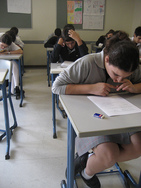DCPS students are getting better at taking tests, but are they getting better at thinking?

Photo by ccarlstead on Flickr.
DC’s 4th- and 8th-graders outperformed every other large urban district in gains on recent standardized tests. That’s great, but does it tell us anything about how they’ll do in high school?
DCPS is justifiably celebrating its students’ gains on recent standardized tests that are administered nationwide. The increases in scores here were larger than in other major city school districts, and DC was the only one of those districts to show gains in reading and math for both 4th-graders and 8th-graders.
But, as everyone seems to acknowledge, we still have a long way to go. And it’s not just because we still have the largest gap in the country between white and minority students. Nor is it only because our scores still trail behind other cities, despite the gains.
It’s because multiple choice tests such as this one (the National Assessment of Educational Progress, or NAEP) may be able to test basic skills, but they don’t do a very good job of testing higher-order thinking. And kids need to be able to do that kind of thinking in order to succeed in high school and beyond.
It isn’t easy to test analytical and critical thinking on a mass scale. One test that purports to do it, and is given to 15-year-olds around the world, is the PISA (Programme for International Student Assessment). The most recent results show that U.S. students as a whole are about average in math, reading, and science. But we don’t know how DC students in particular did on that test.
High school scores are dismal
DC’s own standardized tests are almost entirely multiple choice and therefore don’t really test critical thinking. Still, critical thinking skills can help boost multiple choice scores. And high school students generally perform worse than elementary or middle school students on those tests. While 10th-grade scores on last year’s DC CAS showed some growth, the increases were generally far lower than at other grade levels tested: about 2 percentage points for math and 1 point for reading.
When you look at absolute scores rather than growth, the picture is even bleaker. Lately a lot of attention has been focused on the failings of DCPS’s middle schools, but in fact they pale in comparison to the problems at the high school level.
The 9 neighborhood (i.e., non-selective) high schools other than Wilson, in Ward 3, had an average proficiency level on last year’s DC CAS of 23%. That means 77% of students at neighborhood high schools outside of Ward 3 are performing below grade level, as measured by the test. Overall in DCPS, the percent performing below grade level is 49%.
It’s possible that the current crop of 4th- and 8th-graders will do better on the DC CAS when they’re in high school. Some of the 4th-graders, at least, may have benefited from the expansion of public preschool in DC, and that may have effects lasting through high school.
But even if that’s the case, it’s likely these kids will need a different kind of teaching to really succeed. Teachers will have to ensure that students are absorbing, synthesizing, and critiquing material, not just letting it wash over them.
Using writing as a way of teaching
One proven way to do that is to have kids write about what they’re learning, or ostensibly learning, throughout the curriculum. If it’s done well, that approach forces students to figure out the meaning of what they’ve read or heard, or at least alerts teachers when they don’t understand the material. It also requires them to make connections and comparisons, and to come up with their own ideas.
DCPS is beginning to introduce that method of teaching this year, in an intensive way in four middle and high schools, and in at least some form in other secondary schools. Students are being asked to construct increasingly complex sentences about what they’ve read, using conjunctions like “but,” “because,” and “although.” Once they’ve mastered sentences, they move on to constructing paragraphs, then essays.
That’s certainly a promising development. But all of this would be much easier if students began using this kind of approach at the elementary level. Young kids may not need to think analytically to do well on multiple choice tests that assess basic skills, but if we don’t teach them how to do it we’ll have reason to regret that later on.
Using writing as a teaching tool is not a panacea. Nothing is, in education. But if DCPS can use writing to get its students to absorb information and think critically about it from an early age, the system stands a much better chance of ultimately getting them, as they say, “college and career ready.”
And, for what it’s worth, we’ll probably also see an even swifter rise in test scores.
